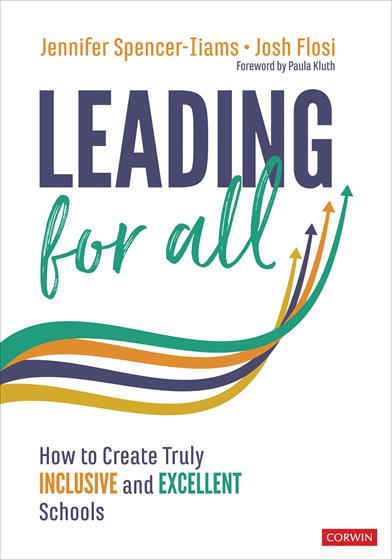
Hands-on, Practical Guidance for Educators
From math,
literacy, equity, multilingual learners, and SEL, to assessment, school counseling,
and education leadership, our books are research-based and authored by experts
on topics most relevant to what educators are facing today.
Leading for All
Foreword by Paula Kluth
Leading for All is a practical guide that provides a clear pathway for educators to develop a more inclusive school community from start to finish.
- Grade Level: PreK-12
- ISBN: 9781071827925
- Published By: Corwin
- Year: 2020
- Page Count: 224
- Publication date: November 12, 2020
Price: $39.95
For Instructors
When you select 'request review copy', you will be redirected to Sage Publishing (our parent site) to process your request.
Description
Develop inclusive and equitable school communities where all learners thrive
Research has shown that inclusive education results in better academic outcomes for ALL students, not just those identified with disabilities, by promoting self-efficacy, improving social and emotional health, and consistently implementing research-based instructional strategies. Still, many schools rely on deeply ingrained, segregated practices that fail to serve all students.
Leading for All is a practical guide that provides a clear pathway for educators to develop a more inclusive school community from start to finish. Authors Jennifer Spencer-Iiams and Josh Flosi share lessons learned from spending nearly a decade building district schools where all students are served in their neighborhood school and in classrooms with their general education peers.
Features include:
- Three focus areas to guide change: Creating Inclusive Cultures, Improving Instructional Practices, and Increasing Student Voice
- 7 Components of Inclusive and Equitable Learning Communities
- Supporting resources for promoting inclusion throughout the school day, including co-curricular activities and transportation
- Stories of real students and teachers and the actions that impacted their success
Educators and school leaders want to create inclusive and excellent educational experiences for all students, but they do not always know how to proceed. Leading for All provides a model, stories, strategies, and clear evidence that it can be done effectively.
Author(s)

Jennifer Spencer-Iiams

Josh Flosi
Josh Flosi has been an educator for 25 years in public, private, and international schools. He currently leads Student Support Services at the International School of Tanganyika, an inclusive school in Dar es Salaam, Tanzania. Before that, he spent 10 years as a building administrator and then Assistant Director of Student Services in the West Linn-Wilsonville School District near Portland, Oregon, where he helped lead the transformation to a profoundly inclusive model of education. He spent 14 years as a high school English and Social Studies teacher. He has also been an adjunct professor in a teacher preparation program and a regular presenter at conferences.
Josh is committed to promoting inclusive and excellent schools, believing that we all have the capacity to learn and the right to belong and contribute to a community. He earned his Bachelor’s and Master’s degrees from Stanford University and his Doctorate in Educational Leadership from the University of Oregon. He enjoys traveling with his family, reading, coaching soccer, and crafting homemade ice cream.
Table of Contents
Foreword by Paula Kluth
Acknowledgments
About the Authors
Introduction
Chapter 1 - Finding Our Why
Why Inclusion?
Academic Research Supports Inclusion
Inclusion and the Whole-Child Movement
Equity and Social Justice
The Perspective of Families
Moving from Why to Why Not?
References
Chapter 2 - What We Mean by Inclusive Education
A Continuum of Inclusive Practices
A Summary of Changes Over the Past Eight Years
What Inclusion Looks Like
References
Chapter 3 - The Foundations of Inclusive Education
Putting Our Goals on Paper
Guiding Principles for Our Work
Kortney’s Story
References
Chapter 4 - Creating Inclusive Cultures
True Friendships
Providing Supports in the General Education Classroom
Shared Ownership and Co-Teaching
The Power of Language
All Students Participate in Cocurricular Activities
References
Chapter 5 - Improving Instructional Practices
Frameworks that Guide our Instructional Practices
Learning Targets
Engagement Strategies
Access to Grade-Level Content
Common and Consistent Data
Analyzing Data to Inform Instruction
Purpose of Evaluation
References
Chapter 6 - The Components of Inclusive and Equitable Learning Communities
Effective Physical Spaces
Teaching Common Expectations
Rituals, Routines, and Recognition
Engagement Strategies for All Students
Teaching Social-Emotional Skills
Restorative Practices
Relationships with High Expectations
References
Chapter 7 - Increasing Student Voice
Growth Mindset Revisited
Student Voice and Behavior
Augmentative and Alternative Communication
Students as Leaders of Change
Students and Their IEPs
References
Chapter 8 - Supporting Behavior in Inclusive Schools
All-Some-Few Thinking
Team “Student”
The Intensive Capacity-Building Team
Thinking Inclusively About Outside Placement
References
Chapter 9 - Leadership Moves to Make it Happen
Communication and Relationships
The Role of the Central Office
Salary Structures, Job Descriptions, and Union Contracts to Support Inclusive Practices
Structures for Professional Learning that Support Inclusive Practices
Structures for Leadership and Stakeholder Input
Partnerships with Other Districts and Outside Organizations
Closing Thoughts about Leadership Moves
References
Chapter 10 - What’s Next?
Transportation
Inclusive Early-Childhood Education
Adult Transition Services and Inclusive College Opportunities
Inclusive Teacher Education
The Mental Health System
Inclusive Practices in the Time of Distance Learning and COVID-19
Closing Thoughts
References
Index
Reviews
"Jennifer Spencer-Iiams and Josh Flosi's journey through inclusion is quite remarkable. They chart a path we should all embrace and share the context and tools to support us effectively. They present a great shared text for teacher teams considering shifts to more inclusive practices."Peter Dillon, Ed.D., Superintendent of Schools
Berkshire Hills Regional School District / Shaker Mountain School Union, MA
“In Leading for All, the authors so vividly paint the picture of what collective student efficacy looks like in practice.”
John Hattie, Laureate Professor“In Leading for All, the authors so vividly paint the picture of what collective student efficacy looks like in practice.”
Melbourne Graduate School of Education
"This is a clear guide for principals, central office leaders, parents, and special education advocacy groups to use while implementing changes that foster a more inclusive environment for special education students on campus and in the community."Dr. Anthony Mays, Senior Director of Schools Division with the Harris County Department of Education
University of Houston Downtown, TX
"Leading for All provides a clear framework that all educators should use to improve inclusive practices. The authors have a clear vision for transformational change that will create inclusive school communities which starts at the classroom level."Ronald D. Wahlen, Director of Digital Teaching and Learning
Durham Public Schools, NC
"Leading for All is a very readable book that integrates a wide-range of current knowledge as to how to create an inclusive learning environment for all students, not just special education students. The authors take us along on their journey, recognizing that this magnitude of change is not easy but is a moral imperative, and provide us with the information to undertake such change.Linda R. Vogel, Professor and Program Coordinator
University of Northern Colorado, CO
For Instructors
When you select 'request review copy', you will be redirected to Sage Publishing (our parent site) to process your request.
Related Resources
- Leading for All: How to Create Truly Inclusive and Excellent Schools [Podcast]
- Teaching SEL Skills [Book excerpt]

